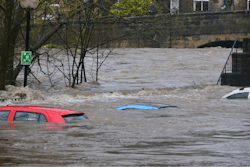
We can't control the weather. Sometimes we can't even predict it accurately. But we do know that along with summer construction season comes summer storms in most areas of the country. These can range from rain and thunderstorms to tornadoes and hurricanes.
You can't stop a summer storm from hitting your construction site, but you can take the following precautions to prepare your sites to weather the storms. Prepare for the worst, and have a plan in place to deal with the aftermath.
[VIDEO] Lightning Safety on the Construction Job
A recent article from Construction Dive focused on eight steps to prepare construction sites for hurricane season. However, these eight steps are a great start for all construction contractors when it comes to summer storm prep whether it be a hurricane or a small storm.
[VIDEO] Tornado Safety Guidelines for the Worksite
Protecting your jobsites
1. Write a preparation plan. Important note: do this before a storm occurs; don't wait until one is imminent or worse surprises you. Your plan can be as detailed as you want. You might even assign a task for everyone on the project or designate a few employees to head up the efforts.
[VIDEO] Reviewing Your Severe Weather Checklist
2. Monitor the weather. It's probably safe to say almost all construction contractors do this. After all, the weather affects your day-to-day work. What's important here is that you continue to monitor the weather throughout the day. As we know, the weather can change in an instant. You might find it helpful to designate one office person or even one person on each project to monitor the weather on a regular basis throughout the day. A weather radio is a good piece of equipment to keep on hand at the jobsite. Mobile devices are also a great resource for checking online weather resource.
3. Work with local building departments. Check with local building officials on what their storm preparedness plans include.
4. Secure jobsite materials. Now we're getting into preparations when a storm is coming. It might not be possible to secure every loose material on a jobsite, but items that can be thrown around in heavy winds should either be tied down or removed from the site. This includes smaller items such as tools to larger items such as dumpsters, portable bathrooms and even equipment.
5. Secure hazardous chemicals. If you have these on your site secure or remove them prior to a storm. And have a third-party team ready to perform the proper cleanup if any hazardous chemicals are spilled during a storm.
6. Plan for water and debris removal. Heavy rains or winds may add items to your jobsite that weren't there before the storm. Or, a significant amount of rain could flood your jobsite. Have a plan in place for how you will safely remove excess water or debris after a storm has passed. Sometimes, you can take this step prior to a storm. If you anticipate the need to pump water, you might be able to place your pumps before hand so pumping can begin as soon as it is needed.
7. Secure the structure - as best you can. If you need to, and you can, board up any windows or wholes to protect the interior of the structure from water damage. If flooding is a possibility, consider placing a sandbag perimeter around the structure. Also, consider what needs to be secured or removed from the structure as well.
8. Conduct a post-storm evaluation. Even a minor storm could cause some damage to your construction site. It's a good idea to conduct a post-storm evaluation of the jobsite and your equipment. If you find damage, assess it with caution. Make a plan for how this evaluation will be done. Will one person be responsible? Will each employee have a task? Who does any damage get reported to?
Protecting your employees
In addition to preparing your jobsites for severe weather safety, it is equally important to prepare and protect your employees working on the jobsites. Here are some tips specifically for employee safety:
- Have a jobsite severe weather plan and make sure all employees know and understand the plan.
- Make sure the jobsite severe weather plan covers all types of severe weather you may encounter in your area (wind, rain, lightening, storms, etc.).
- Have an efficient process to notify all jobsite workers of impending severe weather or jobsite evacuation.
- Identify and clearly mark locations for severe weather refuge. If one isn't available on the jobsite consider coordinating with neighboring buildings for a safe refuge for your employees.
- Assign a jobsite foreman to perform a worker headcount during storm refuge and post storm.
- Remove workers from unsafe working conditions such as cranes, scaffolding and trenches that could flood.
- Review the jobsite severe weather plan at your morning meeting even if no severe weather is currently predicted.
- Make sure to conduct a post-storm jobsite evaluation so you do not place workers in unsafe conditions.







![[VIDEO] Reviewing Your Severe Weather Checklist](https://img.forconstructionpros.com/files/base/acbm/fcp/image/2016/06/default.574ee49a88a8a.png?auto=format%2Ccompress&fit=crop&h=167&q=70&w=250)












